Bulletin – December 2017 Global Economy Ageing and Labour Supply in Advanced Economies
- Download 1.49MB
Abstract
Population ageing is a global trend, which is most evident in advanced economies. This article details the impact of demographic developments on labour supply in advanced economies. The ageing of the workforce has tended to reduce labour supply. This has been mostly offset by increased labour force participation of women and older people. These trends are occurring in Australia, although strong migration has mitigated some of the impact of ageing.

Introduction
Demographic change can greatly affect the size and shape of the workforce. Population ageing, through a long-term decline in fertility rates and increased life expectancy, is most progressed in advanced economies. It has put downward pressure on aggregate labour supply as older workers retire. Other factors have tended to offset this, however, including increasingly delayed retirement and rising female labour force participation. These long-term trends have implications for our assessment of labour market conditions in Australia and its trading partners. Australia has one of the youngest populations among advanced economies, so understanding how its peers are faring with population ageing can provide insights into future labour market trends that Australia may face. This article quantifies the effect of ageing on the supply of labour across a number of advanced economies, highlighting when and how Australian outcomes differ from those of similar economies.[1]
Demographic Developments
Population ageing is a global phenomenon, but is most evident in advanced economies. These economies have the highest median age – at around 40 years – although some middle-income economies, such as China, are ageing more rapidly (Graph 1). The share of the population at prime working age – those aged 25–54 years, who tend to have the greatest attachment to the labour market – peaked almost two decades ago in advanced economies. Across these economies, the speed and trajectory of demographic change varies. Ageing is most evident in parts of high-income east Asia and Western Europe, such as Japan, Italy and Germany. Korea has a smaller share of elderly people, but is ageing more rapidly than other advanced economies, and is projected to have the highest median age in the world by 2050. Australia has one of the youngest populations among advanced economies. Its relatively high net migration rate has helped offset the ageing of the native-born population (Connolly, Davis and Spence 2011). This has contributed to Australia having one of the highest rates of population growth over the past decade across advanced economies (Graph 2).
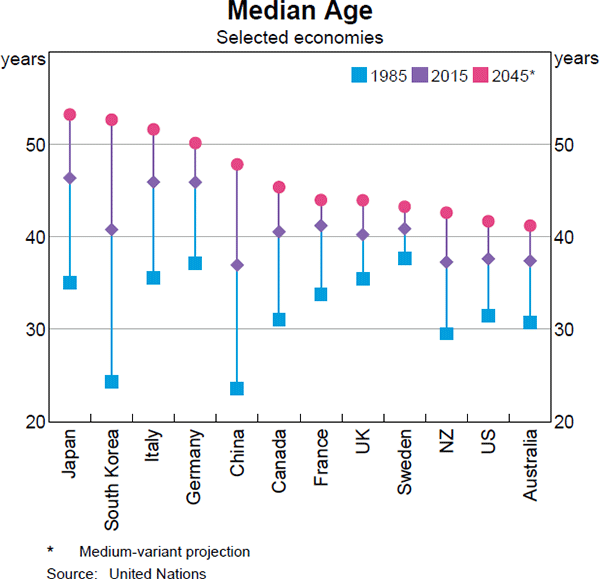
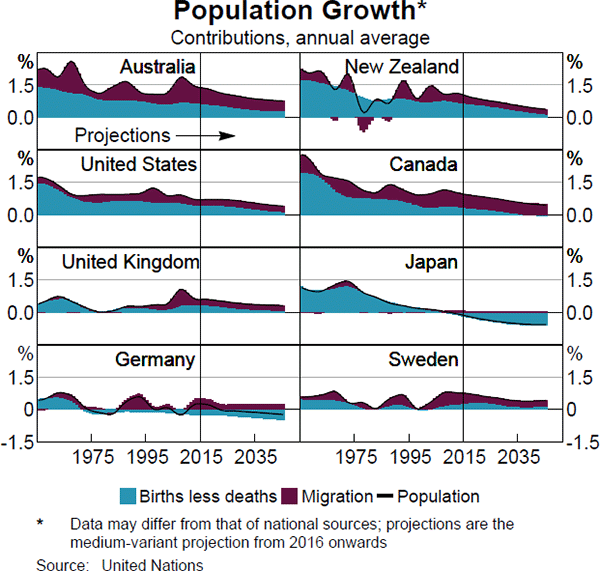
Drivers of Labour Force Growth
The size of the labour force, the part of the population that is employed or actively seeking employment, is a key measure of total labour supply in an economy. Labour force growth is determined by growth in the working-age population (generally defined as those aged 15 and over) and changes in the labour force participation rate (the propensity of working-age people to work or actively seek work). Ageing affects both of these factors through slower population growth and the lower participation of older people as they retire.
Growth in the working-age population has been the main driver of labour force growth for most advanced economies over the past decade (Graph 3). Australia has seen particularly robust growth in its working-age population of 1¾ per cent each year over the past decade. Strong net migration has been a major contributor to this growth. In contrast, Japan and the euro area, which have been ageing faster, have seen less than half a per cent growth in working-age population. This highlights the influence of ageing in putting downward pressure on population growth, and so the size of a country's labour force.
Across countries, the contribution from the participation rate to labour force growth has been mixed. Over the past decade, the participation rate has been relatively stable in Australia, while in the euro area and the United Kingdom it has added slightly to the overall growth in labour supply. Recently, high rates of net migration of working-age people to New Zealand and Sweden and strong growth in female participation in Korea have contributed to noticeable increases in participation rates and, as a result, labour supply growth in these countries (Graph 4). Earlier, in the mid 2000s, Australia also saw a large pick-up in labour force participation, in part associated with the acceleration in net migration at that time. The participation rates in the United States, Canada and Japan have declined substantially since around 2000, causing a noticeable drag on labour supply growth. However, more recently, the tightening of the labour market in these economies as they have recovered from the global financial crisis, appears to have helped arrest the decline.

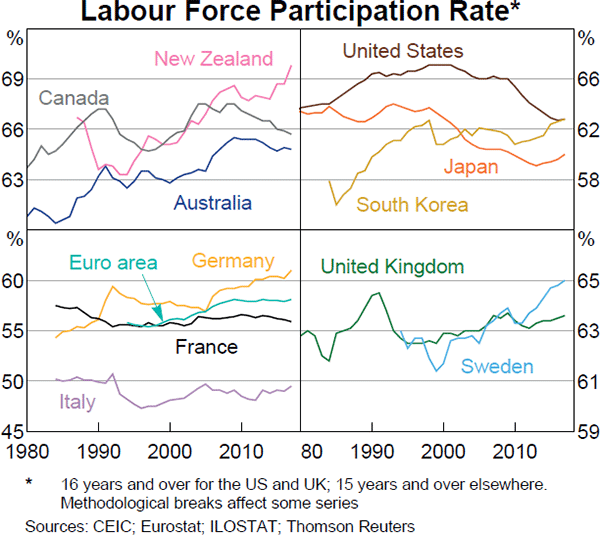
Ageing and Labour Force Participation Rates
The effect of the population age structure on aggregate participation
The tendency for a person to be in the labour force varies by sex and over one's life cycle. Changes in this propensity to work and the demographic structure of the population affect a country's aggregate labour force participation rate and can be separated into a cohort and a demographic effect.[2] The cohort effect is the change in the labour force participation rates for different demographic groups over time. Examples of cohort effects include the increased propensity for females at any given age to be in paid employment over time, or the increasing tendency for young people to enter the workforce later as their access to tertiary education increases.
The demographic effect is the aggregate impact of a shift in age structure of the labour force, keeping the participation rates of different age groups constant. The changing age structure of the population has been a persistent and increasing drag on labour force participation across advanced economies since the mid 1990s (Graph 5). The demographic drag has been widespread, reflecting the broad-based decline in the share of the prime-age population. It has been the largest in Japan, averaging around one-third of a percentage point per year over the past two decades.
Rising female workforce participation over the past few decades has largely made up for the demographic effects of ageing. This positive contribution from rising female participation has been common across advanced economies, although the timing has differed, with changes having occurred earliest and fastest in the United States and Canada. Australia has seen a consistent rise in female participation. Across advanced economies, the increasing participation of females has been incentivised by government policy changes, such as parental leave, child care and part-time work entitlements, alongside changing social attitudes and increased education (Blau and Kahn 2013).
Male participation rates have declined considerably in most advanced economies, partly driven by demographic change. Nonetheless, in recent years, the male cohort effect has tended to be slightly positive, on average, especially in New Zealand and Europe as older workers delay their retirement. The largest negative contribution has been in the United States, reflecting a multi-decade long trend in falling prime-age participation, which has only recently subsided (CEA 2016).
Another way to look at the effect of demographic change is to consider the participation rates that would have resulted if the population share in each age cohort had been unchanged from 2000 – which approximately corresponds to the peak of the prime-age labour share in the population of many advanced economies. This exercise shows that aggregate labour force participation rates would have been higher and mostly increasing across advanced economies (Graph 6). The rise largely reflects the increase of women and older workers in the workforce. The role of ageing in depressing labour force participation is most notable in Japan. Without ageing, Japan's labour force participation rate would be almost 6 percentage points higher. Australia's participation rate would be around 2–3 percentage points higher if there had been no demographic change since 2000; the decline in participation earlier this decade also appears to have been driven by ageing effects. A limitation of this exercise is that ageing and cohort effects are assumed to be independent of each other. However, if the population were not ageing, it is likely that people would make different decisions about their employment.

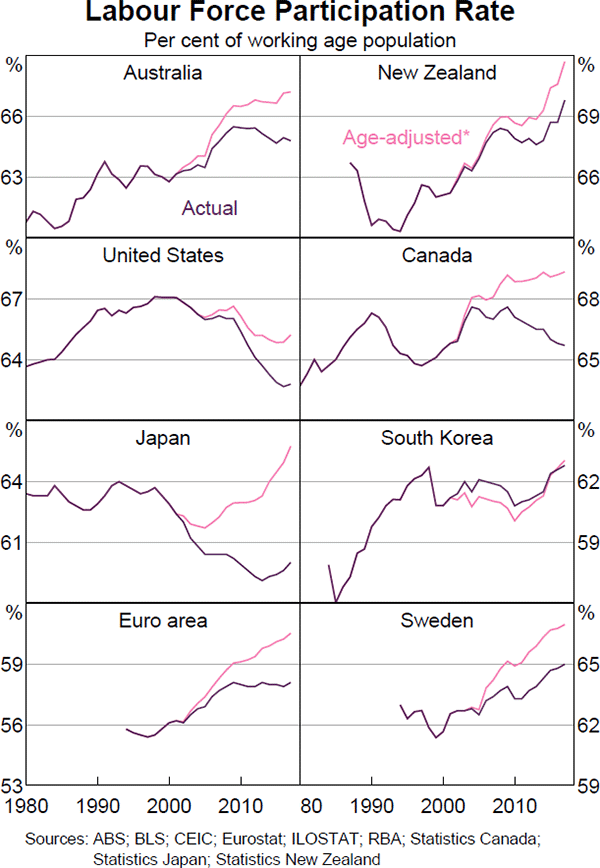
Participation of older workers and retirement policies
The increasing participation of older cohorts in the workforce has occurred alongside significant improvements in health outcomes and life expectancy. Furthermore, increasing longevity incentivises people to work longer to ensure they have adequate savings for retirement. The labour force participation rate of people aged 55 and over has been rising steadily since the mid 2000s across advanced economies, partially reversing a multi-decade decline in the average age of retirement (OECD 2015a). Over the past decade, the participation rate of people in advanced economies aged 55–64 years old and 65 years and over has increased by an average of 9 and 4 percentage points, respectively (Graph 7). For most countries, participation rates of older women have increased by more than those of older men from comparable age cohorts over this period.
Australia's experience of older workers' participation in the workforce is typical for an advanced economy. While euro area countries such as Germany, Italy and France have seen a much larger increase in the labour force participation of older people over the past decade, this represents a catch-up to retirement norms in other advanced economies; the average age of retirement among the euro area countries remains relatively low.
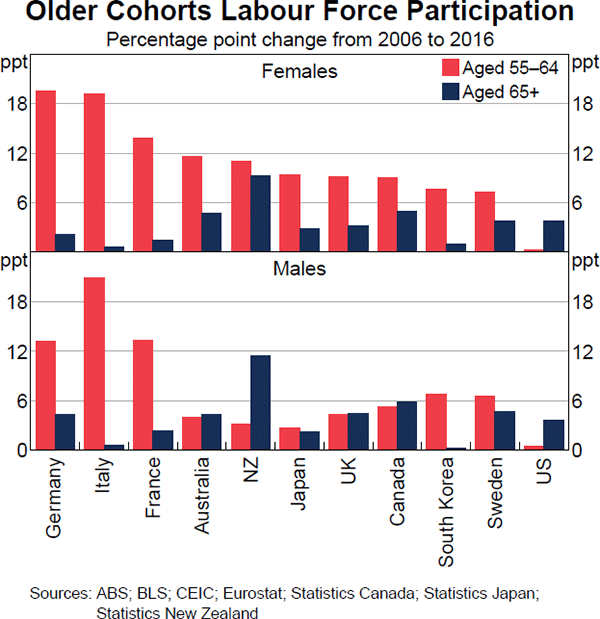
Across advanced economies, the gap between the participation rates of older people and those of prime-age workers is gradually narrowing. This is particularly the case for the 55–64-year-old cohort, which now has a participation rate of less than 20 percentage points below the prime-age cohort in most advanced economies. While there is a limit to the additional labour supply that can be generated by increased participation by older cohorts, the lower participation rates for those over 65 years old suggest there may be some scope to increase labour supply from this cohort. New Zealand, for example, has seen a large increase in labour force participation of this cohort. The New Zealand Treasury (2016) attributes this increase to factors such as labour market flexibility and government policy changes to pension access eligibility. In Japan and Korea, the share of the population over the age of 75 who are in the labour force has been gradually increasing over the past few years.
Rising workforce participation of older workers in advanced economies can be attributed to multiple factors. As well as improving health outcomes and increasing life expectancies across advanced economies, it also reflects: changes to workplace culture that support older workers to remain in the labour force; a shift away from physically demanding employment; and workers' concerns about inadequacy of pension or retirement savings (especially in light of increasing longevity) (OECD 2015b). The official retirement age – the age when individuals are entitled to access retirement savings or government-provided pensions – can also affect retirement decisions. However, given the gradual nature of changes in official retirement ages and the small amount of cross-country variation, these are unlikely to explain the rapid and varied pace of increasing labour force participation by older workers. The effective retirement age – the average age when people actually withdraw from the labour market – differs from the official retirement age, partially because of differences in tax laws, pension access requirements and pension amounts. In Australia, the ability to access the aged pension or superannuation savings is cited by older workers as the main reason for leaving the workforce. For example, the gradual increase in the age that women become eligible for a pension in Australia, from 60 to 65 between 1995 and 2013, was accompanied by an increase in labour force participation of almost 30 percentage points over this period. In Korea, the high effective retirement age mostly reflects financial need; the government-provided pension is low and the elderly poverty rate is high (OECD 2015a).
Labour force projections
As the population in advanced economies ages further it will continue to put downward pressure on the supply of labour; the participation rates of specific cohorts are also likely to continue to change. The potential changes to labour supply over the next 25 years can be illustrated with three scenarios based on different assumptions about how participation rates for different cohorts might change, along with population projections from the United Nations. The scenarios are as follows (Table 1):
- The ‘ageing only’ scenario assumes there are no changes to cohort participation rates from 2016. It illustrates the strong downward pressure that ageing will exert on labour supply. Future participation rates in all economies trend lower as the share of the population accounted for by older cohorts increases. Australia's participation rate is projected to have one of the smaller declines under this scenario.
- An assumption of no change in participation rates by cohort is likely to be pessimistic, so the second ‘cross-country benchmark’ scenario assumes that each economy's cohort-specific participation rate converges to the highest participation rate observed among the included countries since 2000 (the benchmark).[3] This illustrates the impact that a broad-based increase in participation could achieve, although full cross-country convergence is likely to be too optimistic.[4] By 2040, most of the economies are projected to increase their overall participation rates, although those ageing more slowly, such as Australia, converge to participation rates that are around 5–10 percentage points higher than the rapidly ageing Asian and European economies.
- The ‘delayed retirement’ scenario explores the effect of delayed retirement, by projecting the rising participation of older workers.[5] Under this scenario, the aggregate participation rate would remain broadly stable or decrease slightly because the increased participation of older cohorts is offset by the ageing of the workforce.
These scenarios suggest that, while ageing will put downward pressure on participation rates in all advanced economies, increases in cohort-specific participation rates could largely offset this. Despite this, labour force growth is still expected to slow sharply in advanced economies due to slower population growth. This reduction in labour supply is likely to tighten the labour market, all else being equal.
| Australia | Canada | Euro area | Japan | New Zealand | South Korea | Sweden | US | |
|---|---|---|---|---|---|---|---|---|
| 2000–16 | 1.5 | 0.1 | 1.5 | −2.3 | 4.5 | 1.5 | 4.4 | −4.3 |
| 2017–40 projections: | ||||||||
| Ageing only | −4.6 | −6.9 | −7.4 | −5.6 | −5.8 | −5.6 | −4.0 | −3.7 |
| Benchmark | 6.0 | 2.9 | 6.2 | 0.6 | −0.1 | 1.5 | 4.0 | 7.8 |
| Delayed retirement | −1.8 | −2.8 | −2.2 | −0.1 | 0.0 | 1.1 | 0.3 | −2.6 |
|
Sources: ABS; BLS; CEIC Data; Eurostat; ILOSTAT; RBA; Statistics Canada; Statistics Japan; Statistics New Zealand; United Nations |
||||||||
Ageing and Hours Worked
Workers can also adjust their labour supply by changing their hours worked. For example, a worker around retirement age may choose to exit the labour force (thereby supplying no labour) or they may decide to partially retire by transitioning from full- to part-time work. As health outcomes improve, the elderly may work full time for longer, but it is also plausible that many elderly workers will choose partial retirement at some point.
Both older and younger workers are more likely to work part time than prime-age workers (Graph 8). This phenomenon is broad based across countries. Australia's total part-time employment share is high by international standards, although it is less of an outlier for the older age cohort.[6] For those aged above 65 years, part-time work is more prevalent in many European countries. Most part-time workers in the older age cohorts voluntarily work part-time, suggesting reduced work hours is an important element of transitioning to retirement. Pension eligibility also plays a role. In some countries workers are incentivised to limit their hours so they can receive the pension. The part-time employment shares for those aged 55–64 years have been roughly stable over the past decade across advanced economies. They have generally increased for those aged over 64 years. However, in countries that saw substantial increases in the participation rates of their oldest cohort, such as Canada and New Zealand, the part-time employment share declined as more workers remained working full time rather than retire.
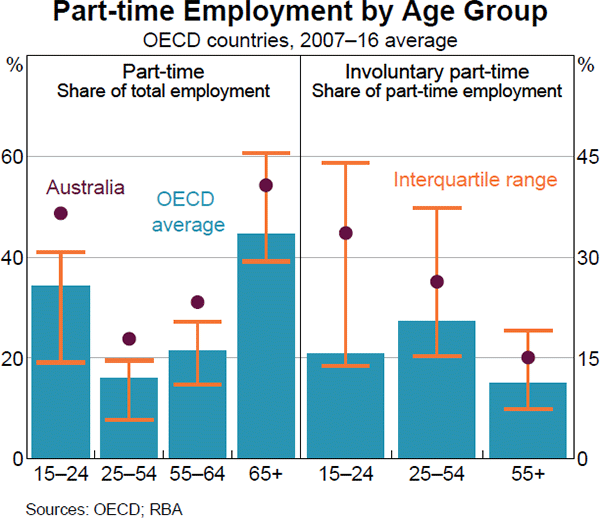
Over the past decade, the increase in part-time work has led to a decline in average hours worked per worker. However, within the part-time worker cohort for those aged over 55 years, average hours have increased. Both demand and supply factors are likely to be driving this increase in part-time hours, such as increased availability of flexible work, financial need and improved health.
In aggregate, total labour hours supplied are likely to continue increasing in less rapidly ageing economies, including Australia, although at a slowing pace as labour force growth slows (Graph 9).[7] In the more rapidly ageing economies, increases in labour force participation rates have kept the supply of hours fairly stable since 2000. However, without further increases to the labour supply (such as migration or increased participation by older or female workers), total labour hours supplied in these economies are likely to fall sharply over the next few decades.
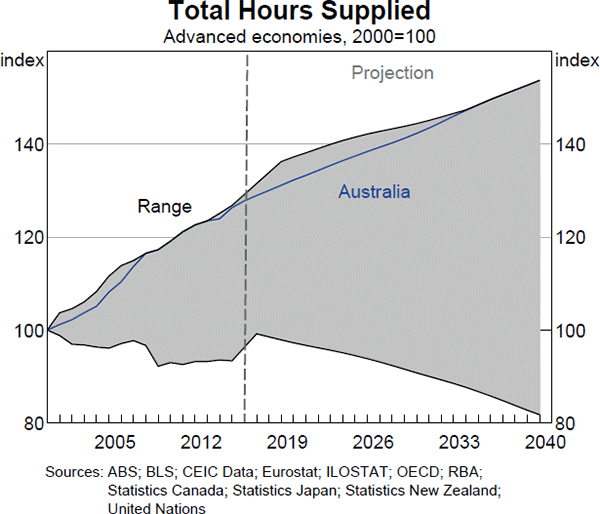
Conclusion
Demographic change is a key driver of labour supply trends. Population ageing has reduced growth in the labour force across advanced economies, although strong migration has lessened some of this impact in Australia. Increased female and elderly workforce participation has partially offset the downward pressure from ageing. Projections show that continued growth in participation by these groups can continue to counterbalance some of the substantial effects of ageing on aggregate participation. Nonetheless, overall growth in the labour force and total hours supplied will continue to slow, all else being equal.
The broader macroeconomic consequences of these developments are uncertain, as demographic change can influence both potential and actual output. Subdued trend growth in labour supply will lower potential output growth and tighten the labour market, all else being equal. This would put upward pressure on wages and inflation. However, there may be offsetting changes in the demand for labour, if, for example, an older population consumes less or labour scarcity leads firms to innovate in order to improve labour productivity (raising potential output). Labour shortages could also see societies open themselves up to increased migration, which would boost labour supply. Overall, while the most likely implication of ageing is a tighter labour market in the longer term, the ageing phenomenon will shape the behaviour of households, firms and governments in ways that are difficult to predict and may go some way to reversing these trends.
Footnotes
The authors are from the Economic Analysis Department. [*]
This analysis focuses on a variety of advanced economies that are either important Australian trading partners or that have demographic profiles that illustrate varied ageing developments. The euro area is analysed as a single labour market in much of this article, although labour laws differ across countries. Data are annual up to 2016. [1]
To do this we follow the methodology of Hotchkiss (2009). [2]
Following Holzmann (2005), the benchmark is the highest participation rate since 2000 for that cohort among a set of advanced economies. These are mostly from Japan for males and Sweden and New Zealand for females. Each cohort's participation rate is increased by 1 percentage point per year until the benchmark level is reached. Demographic shifts are the UN projections. [3]
There has been some convergence in cross-country female participation rates since 2000 (IMF 2017). [4]
The participation rates for older workers (aged over 50) are assumed to increase at the same pace observed over the past five years for each economy, but are constrained to be at or below the current prime-age participation rate. The participation rates for the younger cohorts are held at their 2016 level. [5]
See Cassidy and Parsons (2017) for a detailed review of part-time work trends in Australia. [6]
The graph projects total hours supplied by holding participation rates and hours worked by each age cohort fixed at their 2016 levels, and then calculating the hours supplied by each age cohort using UN population projections. This likely represents a lower bound estimate if participation rates of older cohorts and women increase further. [7]
References
Blau F and L Kahn (2013), ‘Female Labor Supply: Why is the US Falling Behind?’, NBER Working Paper No 18702.
Cassidy N and S Parsons (2017), ‘The Rising Share of Part-time Employment’, RBA Bulletin, September, pp 19–26 .
Connolly E, K Davis and G Spence (2011), ‘Trends in Labour Supply’, RBA Bulletin, June, pp 1–8.
CEA (Council of Economic Advisors) (2016), ‘The Long-Term Decline in Prime-Age Male Labor Force Participation’, June.
Holzmann R (2005), ‘Demographic Alternatives for Aging Industrial Countries: Increased Total Fertility Rate, Labor Force Participation, or Immigration’, Institute for the Study of Labor Discussion Paper No. 1885.
Hotchkiss J (2009), ‘Decomposing Changes in the Aggregate Labor Force Participation Rate’, Federal Reserve Bank of Atlanta Working Paper 2009-6a.
IMF (International Monetary Fund) (2017), ‘Box 1.1: Labor Force Participation Rates in Advanced Economies’, World Economic Outlook, October, pp 37–41.
New Zealand Treasury (2016), ‘2016 Statement on the Long-Term Fiscal Position’, November. Available at <http://www.treasury.govt.nz/government/longterm/fiscalposition/2016/he-tirohanga-mokopuna>.
OECD (2015a), Pensions at a Glance 2015: OECD and G20 indicators, OECD Publishing, Paris.
OECD (2015b), Ageing: Debate the Issues, OECD Insights, OECD Publishing, Paris.